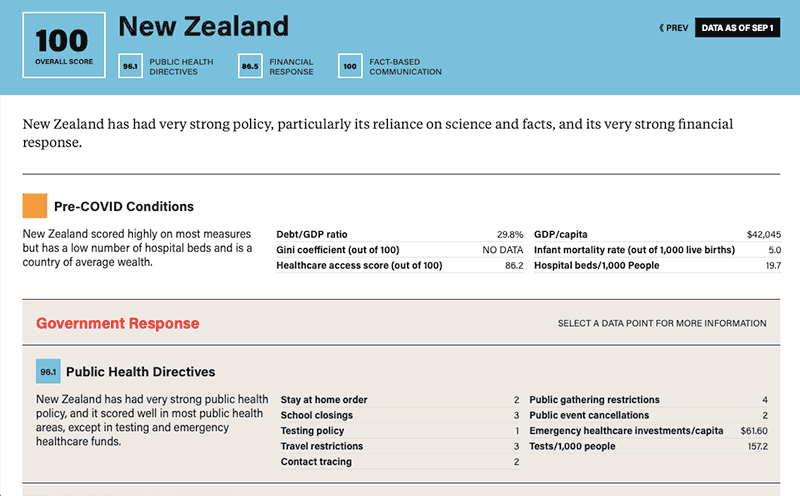Travel and tourism will be changed forever. We asked seven leading thinkers for their predictions.
Spain
- Data as of Aug 1
- Next 》
- 30.7 Public Health
Directives - 23.3 Financial
Response - 80 Fact-Based
Communication
- 30.7 Public Health
Directives - 23.3 Financial
Response - 80 Fact-Based
Communication
Spain's score jumped since January to just over the median, having implemented stricter public health policies, but the country's minimal stimulus support still drags down its overall score.
Pre-COVID Conditions
Spain did well in most subcategories, but its low number of hospital beds likely played a large role in officials struggling with the COVID-19 case spike, bringing its score down.
- Debt/GDP ratio 97.1%
- GDP/capita $43,008
- Gini coefficient (out of 100) 34.7
- Infant mortality rate (out of 1,000 live births) 3
- Healthcare access score (out of 100) 89.6
- Hospital beds/1,000 People 21.2
Government Response
Select a data point for more information(Data points represent policy level as of Aug 1.)
Public Health Directives
Spain has relatively weak public health policy, driven by a relaxed stay-at-home policy, few public gathering restrictions, limited testing, and minimal funds allocated for emergency healthcare spending.
- Stay at home order 2
- Public gathering restrictions 4
- School closings 0
- Public event cancellations 2
- Testing policy 0
- Emergency healthcare investments/capita $89.83
- Travel restrictions 2
- Tests/1,000 people 0.8
- Contact tracing 1
Financial Response
Spain has had a relatively weak financial response, driven heavily by generous income-support and debt-forbearance policy, but the score has been brought down by its small fiscal stimulus.
- Financial stimulus as share of GDP 7.8%
- Income support 2
- Debt forebearance 2
Fact-Based Communication
Spain’s government has been relatively strong in this category, as it has not engaged in misinformation, but it has limited the media’s access to information regarding COVID-19.
- Reliance on science/fact based information 0
- Press freedom 1
COVID-19 Status as of Aug 1
Spain’s early experience of the pandemic, characterized by a very high volume of cases and deaths, put it in the bottom quartile, but it now seems to be testing a wide range of the population, as seen by its very low positivity rate.
- Total deaths 28,445
- Death rate per 100K 608.4
- Total cases 288,522
- Cases per 100K 6,171
- Percent of positive tests 5.1
| Date | Status | New Cases/1M | |
|---|---|---|---|
| 1 | May 26 | Schools, theaters, and exhibitions partially reopen | 12.90 |
| 2 | Jun 10 | Bars and restaurants reopen | 5.97 |
Differentiating Factors
- Strong financial response controlled spread: Spain's success in gaining control of an early and catastrophic coronavirus spread can be largely credited to its generous financial response. The central government announced a 200 billion euro relief package, half of which was earmarked for struggling business and 9 billion euros of which is being used to strengthen regional healthcare systems. Read More
- Government's minimum-income policy preventing layoffs: The government has introduced a guaranteed minimum income scheme which pays up to 70 perecent of salaries and is currently supporting 2 million workers. Spain's Labor Minister announced the extension of this scheme into 2021, to avoid a cliff edge scenario in which millions are suddenly laid off when the scheme ends. Read More
- Major unemployment, especially among youth: Despite this economic support, around one million Spaniards have lost their jobs due to COVID-19, about half of whom are under 35 years old. The government hopes that the creation of new seasonal jobs will benefit the youth population, which already suffered from high levels of unemployment before the pandemic. Read More
Compared with EU Neighbors
-
66.1France 187,919
Cases 2,879
Per 1M 30,265
DeathsFrance maintained its improved public health policy from the early fall, keeping its score relatively strong, although poor contact tracing and a relatively small stimulus package kept it from being higher.
-
67.2Germany 209,653
Cases 2,502
Per 1M 9,141
DeathsGermany has improved its score a bit in the past few months, after a sharp decline in the fall. Its improvements in contact tracing, which are already likely underestimated in the data, and restrictions on public gatherings, have played important roles in this turnaround, although there has been a recent spike in cases, likely due to both recent restriction relaxations and vaccine rollout issues.
-
65.6Italy 247,537
Cases 4,094
Per 1M 35,141
DeathsWhile hit hard by COVID-19, Italy’s reliance on facts and improved contact tracing has helped slow the spread and slightly improved its overall score since January.
Further Reading From Foreign Policy
Be the source of actionable insight.
Select one of the subscription options below to read the full Covid-19 Global Response Index. Unlock even more global intelligence with a subscription to FP Insider.
Already an FP Insider? Log In
Looking for group access? Contact us directly

Statistics and government response factors available on each country profile include:
Pre-COVID Conditions:
- Debt to GDP ratio
- Infant mortality rates
- Hospital beds per 1,000 people
- Gini coefficients measuring inequality
- Health access and quality
COVID-19 Public Health Directives:
- Stay-at home orders
- School-closing policy
- Public-gathering restrictions
- Cancellation of public events
- Testing policy and rates per 1,000 people
- Emergency healthcare spending per capita
- Travel restrictions
- Contact tracing
COVID-19 Financial Response:
- Stimulus package as a share of GDP
- Income support
- Debt-forbearance
Public Communications:
- Instances of misinformation by leadership
- Limitations on press freedom, censorship
Current/Historic In-Country COVID-19 Status:
- Death rates per 1 million
- Case rates per 1 million


